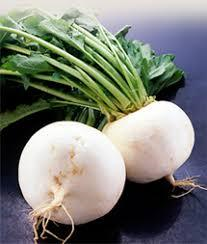
Turnips are a popular, nutritious root vegetable. They are round, tuberous roots grown in many parts of Europe and Asia as one of the cool-season vegetables. Botanically, they belong to Brassicaceae family, a broad family of greens and vegetables which also includes cabbage, kale, brussel sprouts, etc.
Although this bulbous root is widely recognized. Its fresh green tops indeed are more nutritious, several times richer in vitamins, minerals, and antioxidants.
Scientific name: Brassica rapa (Rapifera Group).
Tiny, young turnips or “baby turnips” are harvested quite early at their growing stage. Baby turnips feature a more delicate and sweeter taste and can be eaten raw in salads. However, as they advance in size and maturity, their flavor become more pronounced, lose texture, becoming hard and woody.
Health benefits of turnips
- Turnips are very low-calorie root vegetables. Nonetheless, they are an excellent source of antioxidants, minerals, vitamins, and dietary fiber.
- Fresh roots indeed one of those vegetables that are rich in vitamin-C. 100 grams of fresh root provides about 21 mg, or 35% of DRA of vitamin C. Vitamin-C is a powerful water-soluble antioxidant required by the human body for synthesis of collagen. It also helps the body scavenge harmful free radicals, prevention from cancers, inflammation, and helps boost immunity.
- Turnip greens indeed are the storehouse of many vital nutrients. The green tops compose of many minerals and vitamins several times more than that in the roots. The greens are an excellent source of antioxidants such as vitamin-A, vitamin-C, carotenoid, xanthin, and lutein. Further, the leafy tops are an excellent source of vitamin-K.
- Also, its top greens are also a fine source of the B-complex group of vitamins such as folates, riboflavin, pyridoxine, pantothenic acid and thiamin and also an excellent source of essential minerals like calcium, copper, iron, potassium, and manganese.
Selection and storage
Fresh turnips can be available year-round. However, fresher, and sweeter roots flood the stores in abundance from October through March. Completely grown tubers measure about two to three inches in diameter and weigh between 60 to 250 g.
Fresh tubers usually sold either in the bunch with top greens or topped. In the markets look for fresh roots that are small to medium in size, firm, round and impart delicate sweet flavor. Avoid larger as well as overmatured roots as they are woody in texture due to excess fiber content and, therefore, unappetizing.
Once at home, separate the top greens from the root as the greens rob nutrients off the roots. The roots can be stored for a few weeks at low temperatures (32°-35° F) and high relative humidity (95 percent or above). Use top greens as early as possible since they lose nutrients rather quickly.






